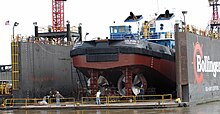
Back Tovera Kort Catalan Kortdüse German Hélice con tobera Spanish Tuyère Kort French Kort-Düüsi FRR Ugello Kort Italian Straalbuis (schip) Dutch Dysza Korta Polish Propeler z okvirjem Slovenian


A ducted propeller, also known as a Kort nozzle, is a marine propeller fitted with a non-rotating nozzle. It is used to improve the efficiency of the propeller and is especially used on heavily loaded propellers or propellers with limited diameter. It was developed first by Luigi Stipa (1931) and later by Ludwig Kort (1934). The Kort nozzle is a shrouded propeller assembly for marine propulsion. The cross-section of the shroud has the form of a foil, and the shroud can offer hydrodynamic advantages over bare propellers, under certain conditions.
Advantages are increased efficiency at lower speeds (<10 knots), better course stability and less vulnerability to debris. Downsides are reduced efficiency at higher speeds (>10 knots), course stability when sailing astern, and increase of cavitation. Ducted propellers are also used to replace rudders.